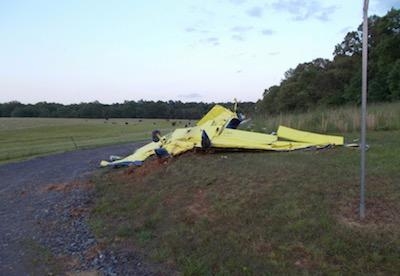Pilot Error Led To The Need To Deploy The Chute, Board Says
The NTSB has released its probable cause report from an accident which fatally injured two people aboard an experimental light sport Jihlavan KP 5 ASA (Skyleader 500), N440JM. The aircraft was destroyed when it impacted terrain in Rhoadesville, VA.

According to the report, the sport pilot had recently purchased the airframe-parachute-equipped light sport airplane and was receiving instruction in it to satisfy insurance requirements. Radar data indicated that, during the flight, the airplane's groundspeed decreased from 94 to 62 knots, consistent with airwork including slow flight and stall practice. Subsequently, several witnesses observed the airplane descending nose-down with the parachute still attached, but with the canopy only partially inflated, before the airplane impacted terrain. The parachute handle was located on the left side of the instrument panel, and the sport pilot likely activated the parachute due to inadvertent spin entry. The previous owner of the airplane stated that he had to be vigilant during stall practice because the airplane always seemed to yaw abruptly right and into a spin, more so than any other airplane he had flown.
The parachute attached to the airframe via four risers. Two of the risers shared a front anchor attached to the aluminum bulkhead behind the seats. The other two risers attached to a rear anchor located at each wing root. Examination of the wreckage revealed that the two front risers remained attached to the shared front anchor but that the anchor had separated from the airframe. The two rear risers had separated in overstress. The front anchor was designed to carry the majority load. The remaining two rear risers were designed to stabilize the airplane in an optimal descent attitude and could not carry the full load if the front anchor failed.
Metallurgical examination of the separated front anchor revealed that it had been bolted into aluminum bulkhead skin that was about 0.022-inch thick. Although the anchor and seven of its eight bolts remained intact, the surrounding aluminum skin of the airplane had separated from the airplane in overstress. Without any additional supporting structure such as longerons, stringers, or bathtub fittings, it is likely the thin aluminum skin could not withstand the force applied to the front anchor during parachute deployment. The investigation noted that the first in-flight deployment of the parachute on the make and model airplane was on the accident airplane during the accident flight. During certification, one test deployment was performed on the ground. Further, the airplane manufacturer was unable to provide any data or testing of the amount of shock force the surrounding aluminum skin could withstand during deployment.
The airplane's maximum takeoff weight was 1,279 lbs. According to the parachute manufacturer, the parachute could be deployed at a maximum weight of 1,350 lbs and a maximum speed of 138 mph. A representative of the parachute manufacturer stated that, although the engine should be off during parachute deployment, it did not have as significant an effect on deployment as airplane speed and weight. Although the airplane was about 50 lbs over its maximum takeoff weight at the time of deployment, it was under the parachute manufacturer maximum weight of 1,350 lbs. Additionally, the pilot likely activated the parachute in the early stages of a spin and closer to stall speed, significantly slower than the 138-mph parachute limit.
The sport pilot had chronic pain treated with multiple medications, including Methadone, an impairing opioid medication, which was detected in blood at levels consistent with chronic use. Further, the sport pilot had insomnia and depression treated with quetiapine and doxepin, both of which are sedating medications. The pilot's recent use of the combination of two potentially impairing medications likely impaired his cognitive and psychomotor function to some degree. However, the investigation could not determine if the pilot's impairment led to a situation that required activation of the parachute. Additionally, there was no evidence that the decision to activate the parachute was inappropriate. Therefore, it is likely that the pilot was impaired by the combination of medications, but there is no evidence that his impairment contributed to the cause of the accident.
The board determined that the probable causes of this accident to be the pilots' loss of control that necessitated the activation of the parachute system and the airplane manufacturer's inadequate design of the front parachute anchor attachment structure, which resulted in a failure of the parachute after it was deployed in flight and precluded the pilots from safely recovering from the spin.
(Image from NTSB accident docket)
 ANN's Daily Aero-Term (04.25.24): Airport Rotating Beacon
ANN's Daily Aero-Term (04.25.24): Airport Rotating Beacon ANN's Daily Aero-Linx (04.25.24)
ANN's Daily Aero-Linx (04.25.24) Klyde Morris (04.22.24)
Klyde Morris (04.22.24) Airborne 04.24.24: INTEGRAL E, Elixir USA, M700 RVSM
Airborne 04.24.24: INTEGRAL E, Elixir USA, M700 RVSM Airborne 04.22.24: Rotor X Worsens, Airport Fees 4 FNB?, USMC Drone Pilot
Airborne 04.22.24: Rotor X Worsens, Airport Fees 4 FNB?, USMC Drone Pilot



